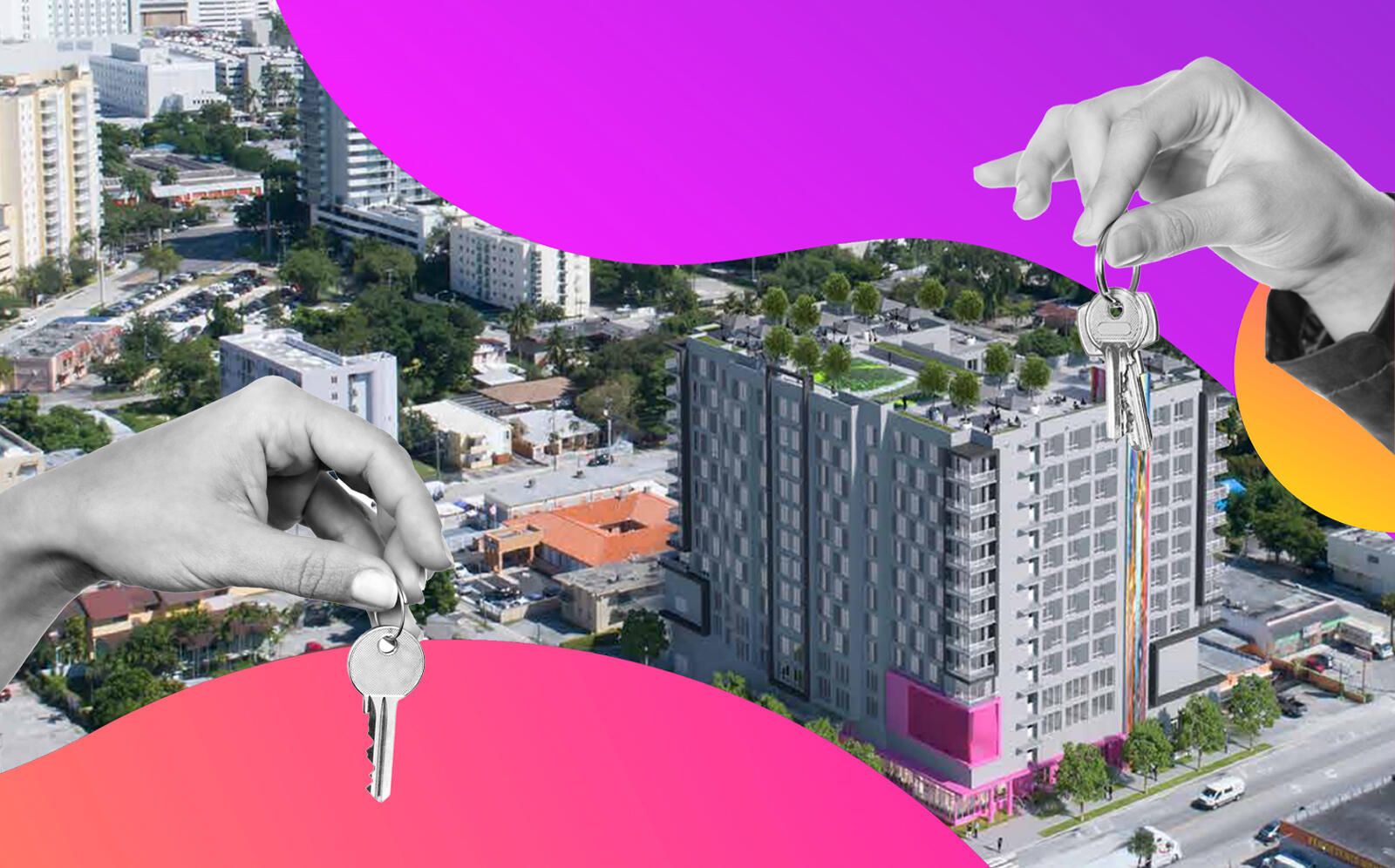Laura Flores is close to calling it quits on her apartment hunt. The 40-year-old Miami resident has done everything to position herself as the perfect candidate: She has a full-time job that allows for $2,400 in monthly rent, and she started searching four months before her current lease ends.
Yet, she has only seen one apartment in Doral since June, despite reaching out to agents about dozens of units. The line at the Doral complex snaked about 25 people long, with some willing to put up a deposit on the spot, sight unseen. Flores’ online search is even less encouraging, with monthly rents on units up $150, $300 or, in some cases, $400 in a matter of weeks.
“I have never seen this type of competition,” said Flores, an office administrator at a Coral Gables public relations and marketing firm. “The current market would benefit more the out-of-towners looking to move to Florida or Miami. I think that is going to benefit them more, because their level of income might be higher, and they may be able to afford it.”
South Florida has long been notorious for catering to well-heeled out-of-staters, while allowing its middle class to become housing cost-burdened. But the current climate of unprecedented rent increases, amid never-before-seen demand, has made renting more out of reach for locals than ever before, according to market analysts.
That thirst for multifamily units extends to both locals and recent arrivals. Locals returning to work are ready to live on their own again after weathering the economic shutdown with family or friends. At the same time, out-of-staters, mainly from the Northeast and the West Coast, are lured to the Sunshine State for its early pandemic reopening, lack of a state income tax and, well, sunshine.

Charles Foschini of Berkadia (Photo by Lynn Parks)
The onslaught has allowed rent hikes to reach lavish levels, up as much as 24 percent in some areas. That has left tenants who get a 10 percent uptick feeling lucky, according to sources.
The turnaround from stable rents – with Miami-Dade posting a drop last year – to scorching rates is uncharted, experts agreed, some of whom have been studying the local market since the 1980s.
“The rental increase and the absorption, meaning how quickly people are moving into new buildings, are unprecedented in what we have seen in South Florida,” said Charles Foschini of Berkadia in Miami.
A record 11,000 multifamily units were absorbed over the past year in Miami-Dade, outpacing supply by 75 percent, according to Florida International University’s Jorge M. Pérez Metropolitan Center.

Nika Zyryanova
No hard data shows newcomers are better positioned to afford higher rents than locals. Yet, while some out-of-staters are getting local jobs at income levels that have long lagged states like New York and California, it is likely not a majority, said Nika Zyryanova, research specialist at FIU’s Metropolitan Center. Many are continuing to work remotely for out-of-state employers — from their new homes in South Florida.
“Why would they move to South Florida only for the view, and get paid less, and kind of overpay the rent?” Zyryanova said. “Assuming those people from New York and elsewhere are moving here with their jobs … now they don’t have to pay the income tax, and they pay less for housing. So from their view it is a win, win, win.”
For New Yorkers, viewed as one of the biggest set of newcomers, local rents are cheap compared with the roughly $3,000 a month they are used to shelling out, Zyryanova said.
By contrast, monthly rates averaged $1,831 in the second quarter across South Florida, including recent rent hikes, according to Berkadia.

Eli Beracha
Meanwhile, landlords are getting picky, especially in light of the current eviction moratorium extended through Oct. 3, making it more difficult to push out non-paying tenants. (At the Doral unit Flores waited in line to see, there is an approval process, including a credit check.)
“You have to show a stronger hand in order to be qualified,” said Eli Beracha, director of FIU’s Tibor and Sheila Hollo School of Real Estate. “This means tenants have to compete with each other.”
To Cali and back
Although Berkadia reported that nearly 234,500 jobs were created or restored over the past year across South Florida, employment is not back to pre-pandemic levels. Miami-Dade’s return to work has been the slowest in the region, with roughly 100,000 jobs still not recovered, according to FIU’s Metropolitan Center. Broward is still 50,000 jobs short, and Palm Beach is roughly 35,000 short, compared with prior to March 2020.
Local back-to-work renters’ incomes continue to trail their out-of-state newcomer counterparts who are working remotely. The median annual income for a single earner in Florida is $52,534, below New York’s $59,956 and California’s $62,171, according to Census Bureau data compiled by the Justice Department from November 2020 to March 2021.
Even before the pandemic, more than half of renter households in South Florida were already cost burdened, paying more than 30 percent of their income to keep a home and pay related bills, according to the Metropolitan Center. The highest was in Miami-Dade with 61 percent, followed by 59 percent in Broward and 56 percent in Palm Beach.
Although the center has not yet accounted for recent rent hikes in its analysis, the issue can only have been exacerbated, Zyryanova said.
Single father of two Matthew Gosling knows the problem well.
The Miramar native came back from California after losing his job at a building paint company at the onset of the pandemic. After living in a couple of South Broward communities, he is back on the market and astonished at the asking rents. A two-bedroom he considered last year for $1,600 a month is now up to $1,900, with little in terms of upgrades or amenities, he said.
“It’s almost catching up to California. I lived up there and I know what the rents are like,” said Gosling, a music engineer. “They are almost catching up to California, but with less pay.”
A reprieve isn’t expected until roughly the second quarter of 2022, as the clamor for apartments will continue, and the 17,500 units under construction in Miami-Dade and Broward won’t make a difference for some time, according to Zyryanova.
Adding to the confluence of factors are delays in planning to zoning and site plan approvals, meaning it could be years for a new apartment complex to be completed.
Although developers are happy with fully leased buildings at higher rents, they are not exactly reaping all the benefits either.
‘Not even a lifestyle’
Lissette Calderon, CEO of Miami-based Neology Life Development Group, finished her 13-story, 192-unit No. 17 Residences in April and leased it out in less than half the projected time.

Lissette Calderon
Across her portfolio, which includes Pier 19 Residences and Marina along the Miami River, she has been able to increase rents on average 10 percent this year. And tenants are renewing.
“We haven’t seen that kind of rent increase on a stabilized project in the recent past,” she said.
She kept rents flat last year and dealt with soaring construction costs amid supply-chain delays and labor shortages, so she welcomes the ability to charge more. “If your construction costs increase, then something else needs to increase,” Calderon said.
Investors from out of state are taking advantage of the hot market, buying up apartment complexes and offering generous purchase prices.
New York-based FBE bought an 814-unit Lauderhill complex for $94.6 million in July; and California-based BJ Verde Properties bought the New River Yacht Club apartments in downtown Fort Lauderdale for $85 million in August.
The most expensive purchase this year came from an Atlanta-based investor. Cortland bought the seven-building Uptown Boca for $230 million in August. It was 99 percent leased when the deal closed.
Rental demand is driven in part from residents who are priced out of homebuying, according to reports and experts. The single-family home-buying spree induced by the pandemic has not only driven up prices but, for those who can afford it, left little inventory. The median home price in the region reached $500,000 in June, a nearly 30 percent jump year-over-year.
It’s a déjà vu of sorts for longtime South Florida residents who are priced out of apartments, as they already were priced out of homebuying. Among them, Flores and her brother, who could not afford to buy a house last year, in part because of a 25 percent down payment requirement from lenders.
As Flores continues to contact agents daily, it is becoming more likely that she and her siblings will take the $200 rent hike at their current Doral unit. They now pay $2,177 a month, Flores said.
Flores, once again in her life, may have to pick up a “side hustle” just to afford rent that approaches 50 percent of her income, she said.
“It’s becoming all about affording your rent, having something to eat,” she said. “It’s not even a lifestyle anymore.”
